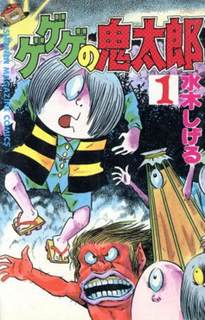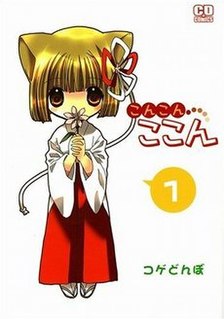
In Japanese folklore, kitsune are foxes that possess paranormal abilities that increase as they get older and wiser. According to yōkai folklore, all foxes have the ability to shapeshift into human form. While some folktales speak of kitsune employing this ability to trick others—as foxes in folklore often do—other stories portray them as faithful guardians, friends, and lovers.

Hyper Police is a Japanese manga series and written and illustrated by Minoru Tachikawa. It is set in a period in the far future, in which humanity is almost extinct and most of the population are monsters. The series mostly follows the offices of a private police company and focuses on the life of Natsuki Sasahara, a young catgirl, and her co-workers: foxgirl Sakura Bokuseiinmonzeninari, werewolf Batanen Fujioka and his cousin Tomy Fujioka.

GeGeGe no Kitarō (ゲゲゲの鬼太郎), originally known as Hakaba Kitarō, is a Japanese manga series created in 1960 by Shigeru Mizuki. It is best known for its popularization of the folklore creatures known as yōkai, a class of spirit-monster which all of the main characters belong to. This story was an early 20th-century Japanese folk tale performed on kamishibai. It has been adapted for the screen several times, as anime, live action, and video games. The word GeGeGe (ゲゲゲ) in the title is Japanese sound symbolism for a cackling noise.
A kumiho or gumiho is a creature that appears in the folktales and legends of Korea. Korean kumiho shares many similarities to the Chinese huli jing and the Japanese kitsune. It can freely transform, among other things, into a beautiful woman often set out to seduce boys, and eat their liver or heart. There are numerous tales in which the kumiho appears, several of which can be found in the encyclopedic Compendium of Korean Oral Literature.
The Amanojaku or Amanjaku is a demon-like creature in Japanese folklore.

The fox appears in the folklore of many cultures, but especially European and East Asian, as a figure of cunning, trickery, or as a familiar animal possessed of magic powers, and sometimes associated with transformation. Literature, film, television, games, music, and other forms of cultural expression may reflect the folklore image and reputation.

The fox spirit is a mythical fox entity originating from Chinese mythology that is a common motif in East Asian mythology.

Kanokon (かのこん) is a Japanese light novel series by Katsumi Nishino, with illustrations by Koin. The first novel was released by Media Factory on October 31, 2005 under its MF Bunko J imprint, and it published 15 volumes until December 24, 2010. A manga adaptation illustrated by Rin Yamaki was serialized in Media Factory's seinen manga magazine Monthly Comic Alive between the August 2006 and August 2010 issues. A drama CD was produced by Media Factory and released on March 28, 2007. A twelve-episode anime adaptation produced by Xebec aired in Japan between April and June 2008 on AT-X, and has been licensed by Media Blasters for release in North America. A two-part OVA sequel aired on AT-X in October 2009. A visual novel named Kanokon Esuii developed by 5pb. was released for the PlayStation 2 on July 31, 2008.

Mermaids, like many other creatures of mythology and folklore, are regularly depicted in literature, film, music, and popular culture. In the folklore of some modern cultures, the concept of the siren has been assimilated to that of the mermaid. For example, the French word for mermaid is sirène, Italian sirena, and similarly in certain other European languages. This usage existed by the Middle Age.

Kon Kon Kokon is a Japanese manga series written and illustrated by Koge-Donbo. The manga is in serialisation in Broccoli Books's magazine, Comi Digi +. In North America, the manga was released by Broccoli Books USA. It is about a boy named Ren who just wants to be one of the cool kids, but he secretly is a nerdy monster fanatic. That is, until a young girl named Kokon shows up. She claims to be a fox that he had helped years ago, and now she wants to return the favor.
Kokkuri or Kokkuri-san (こっくりさん) is a Japanese game popular during the Meiji era that is also a form of divination, based partially on Western table-turning and is very similar to the Ouija board. The name kokkuri is an onomatopoeia meaning "to nod up and down", and refers to the movement of the actual kokkuri mechanism. The kanji used to write the word is an ateji, although its characters reflect the popular belief that the movement of the mechanism is caused by supernatural agents.
Elements from Japanese folklore and mythology have appeared many times in popular culture.

Inari, Konkon, Koi Iroha, also known as InaKon (いなこん) for short, is a Japanese manga series written and illustrated by Morohe Yoshida, which were serialized in Kadokawa Shoten's Young Ace magazine from August 2010 to May 2015. An anime television adaptation by Production IMS aired in Japan between January and March 2014.

The Helpful Fox Senko-san is a Japanese fantasy comedy manga series by Rimukoro. It has been serialized online via Kadokawa Shoten's Comic Newtype website since October 2017 and has been collected in nine tankōbon volumes. An anime television series adaptation by Doga Kobo aired on Japanese television from April to June 2019.
Bakemono no e, also known by its alternate title Bakemonozukushie, is a Japanese handscroll of the Edo period depicting 35 bakemono from Japanese folklore. The figures are hand-painted on paper in vivid pigments with accents in gold pigment. Each bakemono is labeled with its name in hand-brushed ink. There is no other writing on the scroll, no colophon, and no artist's signature or seal.

Kemono Jihen is a Japanese manga series written and illustrated by Shō Aimoto. It has been serialized in Shueisha's shōnen manga magazine Jump Square since December 2016 and has been collected in fifteen tankōbon volumes as of November 2021. An anime television series adaptation produced by Ajia-do Animation Works aired from January to March 2021.










